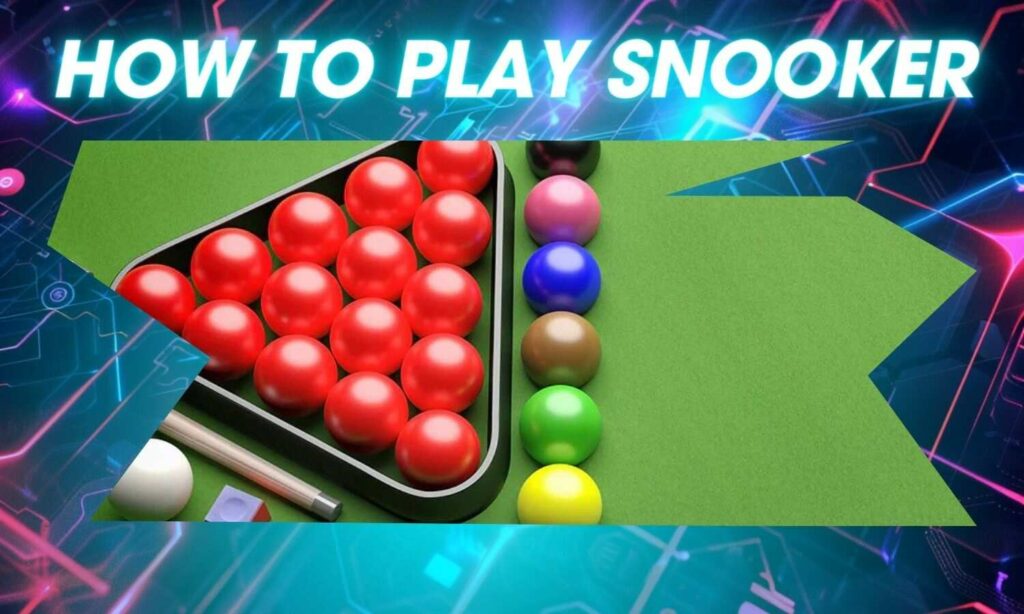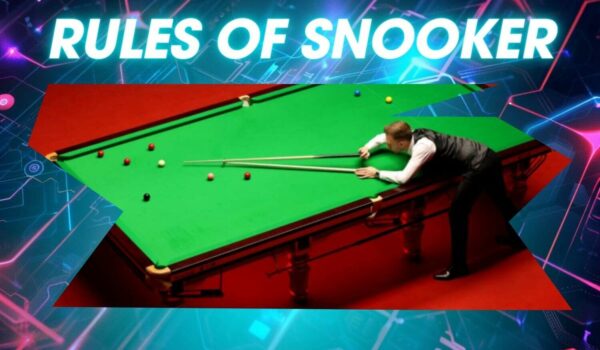Snooker, often regarded as one of the most intricate and elegant cue sports, has enthralled audiences with its strategic gameplay and precise execution. From its origins in the British Empire to its status as a global phenomenon, snooker has captured the imagination of players and fans alike.
In this article, we delve into the rules of snooker, its rich history, gameplay mechanics, equipment, and notable tournaments and players that define the sport today.
Is Snooker a Sport?
Yes, snooker is considered a sport, characterized by its competitive nature, physical skill, and mental acuity. Players must demonstrate precision, control, and strategic thinking to excel in the game, making it a challenging and rewarding pursuit.
Snooker Game History:
Snooker’s origins can be traced back to the latter half of the 19th century in British India, where it was devised as a variation of billiards. The game gained popularity among British Army officers stationed in India and eventually made its way back to England, where it flourished in the early 20th century.
How to Play Snooker:

Snooker Basics
Objective: The goal in snooker is to score more points than your opponent by potting balls of different colors into the pockets on the table.
Equipment:
- A set of 15 red balls
- 6 colored balls (yellow, green, brown, blue, pink, and black)
- A white cue ball
- A snooker table (larger than a standard pool table)
Setup:
- Rack the 15 red balls in a triangle on the pyramid spot.
- Place the colored balls on their designated spots:
- Pink ball in front of the racked red balls.
- Black ball a few inches behind the red balls.
- Blue ball at the center of the table.
- Green, brown, and yellow balls along the baulk line on the opposite end.
Gameplay:
- Players take turns striking the cue ball to hit the red or colored balls into the pockets.
- Alternate between hitting red balls and colored balls.
- Each color has a different point value (1–7).
- After potting all red balls, shoot the colored balls in ascending point order.
Winning:
- The player with the most points when all balls are pocketed wins the frame.
- Snooker matches are usually played to the best of 11, 15, or 17 frames.
Snooker is played on a rectangular table covered with a green baize cloth, featuring six pockets and designated spots for the colored balls. Players use a cue stick to strike a white cue ball, aiming to pot red balls followed by colored balls in a specific sequence.
What is the Difference Between Pool and Snooker:
| Aspect | Pool | Snooker |
| Balls Used | – Typically played with one black ball, 7 yellow balls, 7 red balls, and a white cue ball. | – Played with 15 red balls, 6 colored balls (yellow, green, brown, blue, pink, black), and a cue ball. |
| Table Size | – Pool tables are smaller. | – Snooker tables are larger. |
| Pocket Size | – Pool table pockets are larger. | – Snooker table pockets are smaller. |
| Scoring System | – Points awarded for potting balls in accordance with the rules. | – Complex scoring system involving red and colored balls. |
| Gameplay Style | – Faster-paced, with fewer balls in play. | – More strategic, with multiple balls and specific potting sequences. |
| Variations | – Various pool game variations (e.g., 8-ball, 9-ball). | – Standard snooker rules apply globally. |
While both pool and snooker involve using cue sticks to pot balls into pockets on a table, there are significant differences between the two games. Pool is played on a smaller table with fewer balls and simpler rules, while snooker is played on a larger table with more balls and complex scoring mechanics.
Variant of Snooker:
| Variant | Description |
| Six-Red Snooker | – Played with six red balls instead of fifteen. – Faster-paced and more aggressive. |
| Snooker Shoot Out | – High-speed version with a shot clock for each shot. – Single-frame knockout format. |
| Sinuca Brasileira | – Brazilian variant with unique rules and scoring. – Played on smaller tables. |
| American Snooker | – Played on smaller tables common in North America. – Different rules and ball arrangement. |
| Volunteer Snooker | – Popular in the mid-twentieth century. – Specific rules and variations. |
One popular variant of snooker is “snooker plus,” which incorporates additional colored balls and scoring opportunities into the game. This variant adds an extra layer of complexity and strategy for players seeking a greater challenge.
Object of Snooker:
The objective of snooker is to score more points than your opponent by potting balls into the pockets in accordance with the rules of the game. Players must demonstrate precision, positional play, and tactical awareness to control the table and accumulate points effectively.
Equipment Used in Snooker:
| Equipment | Description |
| Snooker Table | – Rectangular table covered with green cloth (baize). – Pockets in corners and middle of long sides. |
| Cue Sticks | – Wooden sticks used to strike the cue ball. – Usually just under five feet long. |
| Balls | – 15 red balls (arranged in a triangle). – 6 colored balls (yellow, green, brown, blue, pink, black). |
| Cue Bridges | – Used for difficult shots across longer distances. |
| Chalk | – Applied to the cue tip for better grip and spin on the cue ball. |
| Extensions | – Attachments to lengthen the cue stick. |
| Rests | – Various types (hook rest, spider, swan) for steadying shots. |
| Ball Marker | – Marks the exact spot where the cue ball was located before cleaning. |
| Towels | – Used to clean cue balls during play. |
| Table Brush | – Keeps the table surface clean and free of debris. |
| Table Cover | – Protects the table when not in use. |
| Table Iron | – Ensures the baize is smooth and flat. |
Key equipment used in snooker includes a snooker table, cue sticks, a set of snooker balls (including 15 red balls and six colored balls), and a triangle rack for setting up the balls at the beginning of each frame.
Snooker Ball Points and Order:
| Ball Color | Point Value |
| Red | 1 |
| Yellow | 2 |
| Green | 3 |
| Brown | 4 |
| Blue | 5 |
| Pink | 6 |
| Black | 7 |
In snooker, each ball carries a specific point value, with red balls worth one point each and colored balls worth varying points (yellow-2, green-3, brown-4, blue-5, pink-6, black-7). Players must pot a red ball followed by a colored ball in sequence until all red balls are potted, after which they can pot the colored balls in any order.
Snooker Scores:
Scores in snooker are calculated based on the cumulative point value of balls potted by each player during a frame. The player with the higher score at the end of the frame wins the frame, and the player who wins the most frames wins the match.
Snooker Governing Body:
The World Professional Billiards and Snooker Association (WPBSA) serves as the governing body for professional snooker, overseeing tournaments, rankings, and player conduct. The WPBSA works to promote and develop the sport of snooker on a global scale.
Amateur Snooker Events:
| Event | Description |
| IBSF World Snooker Championship | – Also known as the World Amateur Snooker Championship. – Premier non-professional snooker tournament. – Sanctioned by the International Billiards and Snooker Federation (IBSF). – Past champions include Jimmy White, James Wattana, Ken Doherty, and Stuart Bingham |
| English Amateur Tour | – Organized by the English Partnership for Snooker and Billiards (EPSB). – Open to English players. – Offers direct qualification to the European Billiards and Snooker Championships |
Amateur snooker events provide opportunities for players of all skill levels to compete in organized competitions and showcase their talent. These events often serve as stepping stones for aspiring players looking to transition to the professional circuit.
Most Prestigious Snooker Tournaments:
| Tournament | Description |
| World Snooker Championship | – The oldest and most esteemed tournament. – First held in 1927. – Staged as a knockout tournament continuously since 1969. – Considered the pinnacle of professional snooker. |
| The Masters | – Annual invitation-only snooker tournament since 1975. – Features the world’s top 16 players. – Known for its prestige and unique format. |
| UK Championship | – Held annually since 1977. – One of the Triple Crown events. – Attracts top players from around the world. |
Several prestigious snooker tournaments are held annually, including the World Snooker Championship, UK Championship, Masters, and the China Open. These tournaments attract top players from around the world and offer substantial prize money and prestige.
Snooker Players Ranking:
| Rank | Player | Total Prize Money (GBP) |
| 1 | Ronnie O’Sullivan | £1,089,000 |
| 2 | Judd Trump | £1,051,000 |
| 3 | Mark Allen | £945,000 |
| 4 | Luca Brecel | £730,500 |
| 5 | Mark Selby | £658,500 |
| 6 | Shaun Murphy | £468,000 |
| 7 | Ding Junhui | £456,500 |
| 8 | Mark Williams | £427,500 |
| 9 | Ali Carter | £413,000 |
| 10 | John Higgins | £393,500 |
Professional snooker players are ranked based on their performance in sanctioned tournaments and events. Rankings are updated regularly to reflect players’ current form and standing within the professional circuit.
Professional Female Snooker Players:
| Player | Nationality |
| Aimee Benn | England |
| Maria Catalano | England |
| Reanne Evans | England |
| Ng On Yee | Hong Kong |
| Nutcharut Wongharuthai | Thailand |
| Rebecca Kenna | England |
| So Man Yan | Hong Kong |
| Emma Parker | England |
| Siripaporn Nuanthakhamjan | Thailand |
| Ploychompoo Laokiatphong | Thailand |
While snooker has traditionally been dominated by male players, there is a growing presence of talented female players competing at both amateur and professional levels. Players like Reanne Evans and Ng On Yee have achieved success and recognition in the sport, paving the way for future generations of female snooker players.
Who is Playing Snooker Today?
Today, snooker continues to captivate audiences with its blend of skill, strategy, and drama. Professional players from around the world compete in tournaments across the globe, thrilling fans with their precision and flair on the baize.

